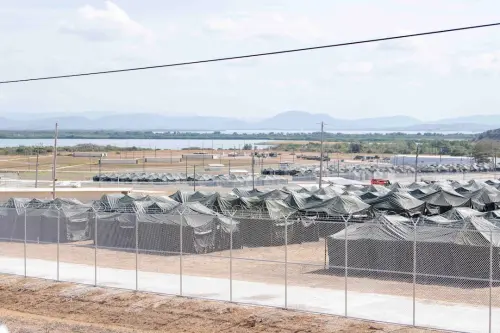U.S. President Donald Trump deported 37,660 individuals during his first month in office, according to previously unpublished Department of Homeland Security data. This figure is significantly lower than the average monthly deportations of 57,000 during Joe Biden's last full year in office.
Experts and a senior Trump administration official indicated that deportations are expected to increase in the coming months as Trump explores new strategies to enhance arrests and removals. DHS spokesperson Tricia McLaughlin noted that Biden-era deportation figures may appear "artificially high" due to elevated levels of illegal immigration.
Trump campaigned on a promise to deport millions of undocumented immigrants, aiming for the largest deportation operation in U.S. history. However, initial data suggests that he may struggle to reach the heightened deportation rates seen during Biden's administration, when large numbers of migrants were apprehended while crossing illegally, making them easier to deport.
Caleb Vitello, the acting director of U.S. Immigration and Customs Enforcement (ICE), was reassigned last week due to unmet expectations, according to a Trump official and other sources. Some expect the deportation effort to gain momentum in the coming months, supported by agreements with Guatemala, El Salvador, Panama, and Costa Rica to accept deportees from other countries.
The U.S. military has participated in numerous deportation flights to Guatemala, Honduras, Panama, Ecuador, Peru, and India. The Trump administration has also announced plans to prepare for the detention of up to 30,000 migrants at the U.S. naval base in Guantanamo Bay, despite opposition from civil liberties groups.
According to security expert Adam Isacson, military-assisted deportations could expand given the Pentagon's significant budget and resources. The administration is also focusing on arresting deportable migrants without criminal records and detaining more individuals with final deportation orders.
The Justice Department recently issued a memo allowing ICE officers to arrest migrants at U.S. immigration courts, reversing a Biden-era policy that restricted such actions. Additionally, the U.S. State Department has designated Venezuela's Tren de Aragua and seven other gangs as terrorist organizations. Under U.S. immigration law, alleged gang members and those connected to these groups may become deportable.
The Trump administration is also collaborating with ICE's investigative arm, the Justice Department, the IRS, and the State Department to facilitate arrests and investigations. Jessica Vaughan, policy director at the Center for Immigration Studies, which advocates for reduced immigration levels, stated that these investigative agents could help address employers who hire undocumented workers and those with final deportation orders.
During Trump's initial three weeks in office, ICE arrested approximately 14,000 people, according to border czar Tom Homan. This equates to about 667 arrests per day, almost double the previous year's average, but not on track for the millions initially promised.
ICE arrests ranged from 800 to 1,200 per day during Trump's first week, but as detention centers filled, officers returned home to target specific cities. Isacson described the early months as akin to "turning a supertanker," noting that the civilian part of the U.S. government has limited capacity.
In Trump's first month, ICE doubled the arrests of individuals with criminal charges or convictions compared to the previous year. Although arrests have increased, ICE's capacity remains a constraint, with around 41,100 detainees currently in custody, just shy of its 41,500 funding limit.
Out of the 19,000 individuals arrested by ICE, approximately 2,800 had no criminal record, up from 858 in mid-January prior to Trump's administration. The Republican-led U.S. Senate recently proposed a $340 billion funding plan for border security, deportations, energy deregulation, and increased military spending. However, divisions within the party remain over how to proceed with this funding, with Trump advocating for it to be linked to tax cuts.
